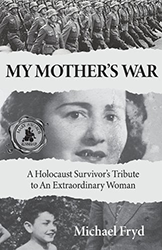Ruth Gruener was a hidden child of the Holocaust who survived the Nazi occupation of Poland and Ukraine when Christian neighbors in the city of Lvov helped her. Unlike many other such children, her parents also found shelter and the family was eventually reunited and liberated together. Ruth, who later became a gallery educator at New York City’s Museum of Jewish Heritage: A Living Memorial to the Holocaust, has filled a specific niche with her memoir. Over the course of her life, she has encountered both ignorance about the near-total annihilation of Europe’s Jews and a reluctance to engage with its difficult history. In her personal life, Ruth gradually learned that attempts to suppress her past have only added to her suffering. While the early part of the memoir chronicles how Ruth, at that time known as Luncia, managed to escape death while so many around her perished, the rest of the book documents her life as a refugee in New York. The underlying motif of this moving story is memory, and the personal and public obligation to continue speaking about the Holocaust.
The adult Ruth recalls her rather ordinary childhood as idyllic, offering no warning about the events which would uproot her family, and end the lives of two out of every three European Jews. While other memoirs of the era emphasize the routine antisemitism which surrounded Jewish communities, Ruth looks back only at the loving warmth of her parents and their seemingly secure place in Lvov. When Christians agree to hide Ruth and her parents, the risk which these rescuers incurred, combined perhaps with underlying attitudes about Jews, make some of them disdainful of those whom they protect. In one macabre scene, Ruth recalls a conversation which her mother had with Mrs. Oyak, a woman sheltering their family. When, out of desperation, Ruth’s mother suggests that their family might commit suicide by arranging to be shot, Mrs. Oyak cheerfully suggests that she might be able to arrange this scenario.
Ruth’s narrative changes when she arrives with her family in New York, where they are staying with relatives until they can find a home of their own. She builds a new life — finding friends in high school and finally gaining the education of which she had been deprived for years. As a young adult, her story seems to gain nuance. Some of the extended family members offer their unstinting support, while others are resentful of the burden placed on them. At key moments, Ruth suffers flashbacks to the traumas of her past, and gradually realizes that avoiding terrible memories only increases their hold over her life in the present. She also comes to understand that her reactions parallel the insensitivity of many around her, even Jews, who are unwilling to listen when survivors tell their stories. When her father tries to tell his own sister about the death of their mother, his brother-in-law cuts him off with a defensive warning: “We don’t need to hear that now…It’s too sad to talk about.” In an especially poignant anecdote, Ruth is proud when a teacher praises a personal essay in which she describes her experiences in hiding, promising that it will be published in the school’s yearbook. Later, she is called to the principal’s office and kindly told that the essay will not appear because “It’s too sad for our children.”
There is deep affection in Ruth’s descriptions of how she met her husband, Jack, with whom she would raise a family. Her growing sense of confidence and security reflects the same process for other immigrants: “Looking back, becoming American wasn’t a single moment, but rather a collection of smaller moments.” There has never been a point in her long life, however, when she ceased to bear witness. Her pointed conclusion about ignorance and denial of the Holocaust reaffirms the need to remember: “But our silence was dangerous. People told our stories for us. If we had told them too, there would have been many more voices speaking truth.”
Out of Hiding is highly recommended and includes a note from the author and photographs.
Emily Schneider writes about literature, feminism, and culture for Tablet, The Forward, The Horn Book, and other publications, and writes about children’s books on her blog. She has a Ph.D. in Romance Languages and Literatures.




